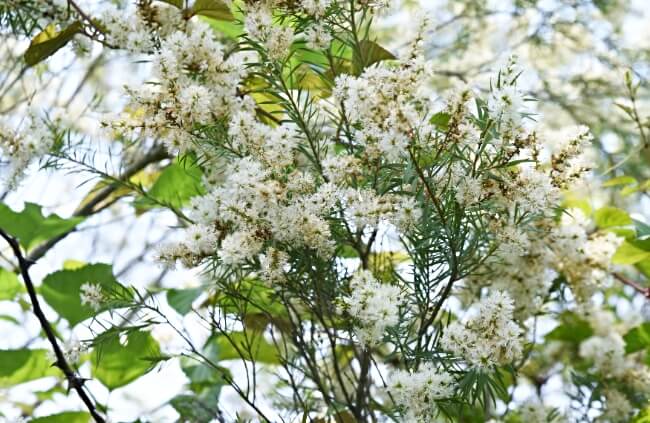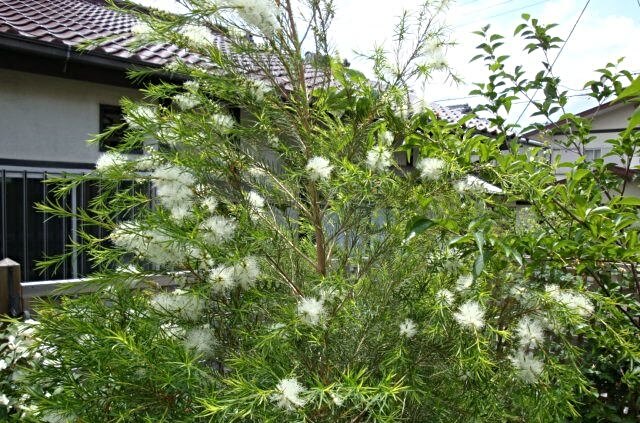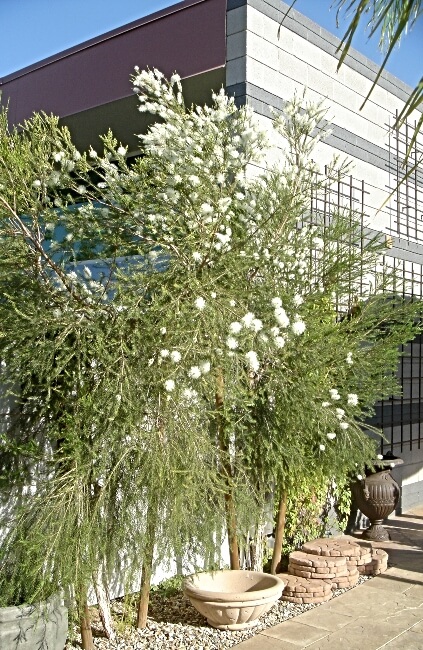I'm delighted to be covering a powerful Australian medicinal plant in today's guide, Melaleuca alternifolia! Famous for its essential oil, it is also a celebrated warm garden ornamental across Australia.
Known as the Australian tea tree, this is actually the primary species for the commercial production of native tea tree oil, also known as Melaleuca oil. A dominant evergreen species, it sports snow-white fluffy flowers, fine and fragrant needle-like foliage, and a bushy crown, all offering many applications within residential gardens.
If you're interested in establishing Melaleuca alternifolia, read on for everything you need to know to grow and care for this special native addition in your garden!
More...

Family: | Myrtaceae |
|---|---|
Genus: | Melaleuca |
Species: | M. alternifolia |
Common names: | Tea tree, Narrow-leaved paperbark, Australian tea tree |
Origin: | Australian native |
Location: | Outdoor |
Type: | Small tree or large shrub |
Growth: | 5 to 10 metres tall, 2 to 5 metres wide |
Sun requirements: | Full sun |
Foliage colour: | Green |
Flower colour: | White |
Flowering: | Spring to summer |
Maintenance level: | Low |
Poisonous for pets: | Plant oil is toxic to humans, cats, dogs and horses if ingested |
Introducing Melaleuca alternifolia
Further elevating the tree's beauty in gardens is its textured white papery bark, also called 'paperbark'. I adore these flowers as well! They are borne in masses at branch ends from spring, adding a lovely snow-in-summer influence to outdoor spaces. It's magical!
Much like its close white-flowering relative, Melaleuca linariifolia, this species is also part of the Myrtaceae (Myrtle family) of plants.
Native to eastern Australia, it occurs mainly in Queensland and New South Wales and is often found growing in the tropical and subtropical swampy areas of these regions.
Botanically labelled Melaleuca alternifolia, the species is also commonly known as tea tree, Australian tea tree, or the narrow-leaved paperbark. While it can tolerate many endemic climates, the tree prefers warmer garden conditions.
Considered fast-growing, it will typically reach about 5 to 10 metres tall and 2 to 5 metres wide when cultivated in residential gardens.
Caution: Tea tree oil is very toxic to humans, cats, dogs, and horses if ingested. It may also cause skin irritation in some individuals if used topically.
How to Grow Melaleuca alternifolia
You can reliably propagate this species using seeds and cuttings. Alternatively, you can establish a young and healthy nursery plant requiring much less effort.

Source: Onszaden
Growing Tea Tree from Seeds
Sow seeds in spring or autumn to avoid the harshest months of the year. Sow on the surface of the seed-raising mix, pressing lightly into the surface but not burying the seed. Mist after sowing using a spray bottle then keep the seed warm and moist.
Try to prevent the soil from drying out or waterlogging the growing mix. Ideal temperatures are 18-22°C with germination occurring within 28 days.
Propagating Tea Tree Using Cuttings
Using sharp and sterile pruning shears, take a healthy cutting from the current season's growth that is about 15cm long. Plant the cutting into a well-draining container filled with a quality potting or propagation mix.


Get Your Free Guide:
Master Growing Australian Natives eBook
A Must Have Complete Guide for Every Australian Garden
Get Your Free Guide:
Master Growing Australian Natives eBook
A Must Have Complete Guide for Every Australian Garden
Water well then place the cutting in a warm sheltered location that gets warm indirect light. Allow cutting to develop properly before moving it to the garden.
Ideal Conditions for Planting Tea Tree
This hardy Australian native performs well in warm gardens, often requiring little maintenance and care.
Ideal Soil
The species grows well in a range of soil types but it prefers moist, easily draining soil with an acidic to neutral pH level (4.5-6). A loamy or sandy soil would work great! Try to avoid heavy clay soils due to their sluggish drainage.
Lighting Needs
Australian tea trees need full sun to thrive! Pick a planting site that gets at least 6 hours of full sun daily. This species does not handle shady conditions too well, especially in cooler gardens.
Spacing
These vigorous trees are known to get big in good conditions. Pick a planting site that will offer enough space for growth, especially if you intend to grow a larger specimen. Alternatively, you can prune more often to maintain your desired shape and size.
Caring for Melaleuca alternifolia
Tea trees are easy to care for in Aussie gardens. It's a big reason why they are so popular! Let's look at the basic care required for this species to thrive.

Source: Australian Outback Plants
Watering Narrow-Leaved Paperbark
Water well and deeply during the plant's first summer and in dry spells. Water to keep the soil slightly moist at all times during summer then cut back slightly in winter.
Pruning Needs
Prune after flowering to keep it tidy and remove any dead and damaged branches. If you want to keep the tree smaller or grow it as more of a large dense shrub, you can cut it back to about knee height every 2 to 3 years. This will keep it vigorous, tidy, and attractive for smaller spaces.
Fertilising Tea Trees
Fertiliser may not be needed in ideal conditions, but if your tree is growing slowly or not looking its best, you can use an organic water-soluble fertiliser for native plants in spring. The wrong or too much fertiliser can cause damage so be as sparing as you can when feeding.
Overwintering
If you live in a colder climate, you can successfully grow this plant in a container. This will allow you to give it outdoor sun during summer and then move it indoors in winter to give it a warm but sheltered environment with bright light.
Tea Tree Pests and Diseases
When grown in Australia, this species is generally pest and disease-free!
How to Use Tea Tree Oil
The essential oils of this species, known as tea tree oils, have been used for thousands of years by Indigenous Australians as a natural treatment for wounds or infused into brews for throat infections.
Today, these oils are still used in many commercial medicinal and cosmetic applications. The tea tree oil is found in the leaves and twigs of the plant and is believed to contain many antibacterial properties and antifungal properties.
At home, you can use a few drops of oil at a time as an effective treatment for stings, burns, wounds, and mild skin infections. It can also be used for aromatherapy to treat coughs or to help with bacterial and fungal infections.
Caution: These oils are professionally extracted using careful procedures, please do not attempt to extract oils from home. Do not consume tea tree oil. It is used in topical formulations with many tested commercial products available as over-the-counter skin products like soaps, lotions, and medicinal ointments. Some may experience skin irritation.
Melaleuca alternifolia Frequently Asked Questions

What is Melaleuca alternifolia oil good for?
Tea tree oil, also known as Melaleuca oil, is a native essential oil commonly used as a medicinal ingredient in commercial skin care products to treat many conditions including acne, nail fungus, insect bites and lots more.
Can you put tea tree oil directly on your skin?
It is considered safe to apply tea tree oil to the skin, but it is good to note that many individuals may have adverse reactions to the oil. It is known to cause skin irritation and swelling in sensitive users, and some may even experience skin itching and burning.
People with allergies to other plants may want to consult their physician before use.
Is Melaleuca alternifolia poisonous?
Published studies on the plant indicate that tea tree oil is toxic if ingested in high doses and can cause skin irritation in higher concentrations of formulas. The oil is also very toxic to animals if ingested – including dogs, cats, and horses.
Should you dilute tea tree oil before applying it to your skin?
Tea tree oil is highly concentrated and should always be diluted before use. If not, the oil alone can cause dryness, blistering, and skin rashes.
How fast does Melaleuca alternifolia grow?
This vigorous Australian species is considered fast-growing, able to grow 1-1.5m each season in good conditions. Be sure to leave enough space for your tree to grow properly without causing damage to underground piping or nearby structures.
Does tea tree grow in South Australia?
Most tea tree species are native to eastern Australia but after years of commercial cultivation, they have now also naturalised in Western Australia and South Australia.
How did indigenous Australians use tea tree oil?
The Bundjalung people traditionally heated the tea tree leaves and inhaled the vapours to treat coughs, colds, sore throats and more. They would also mix a mass of leaves with warm water to topically treat wounds and skin infections.
Which country produces the most tea tree oil?
Australia is known as the largest producer and exporter of tea tree oil globally, with just over 85 native species of trees and shrubs in Australia.
Enjoy White Summery Flowers with Melaleuca alternifolia!
With its fluffy white flowers, white papery bark, and its fine-leaved foliage, the Australian tea tree is an excellent pick for any warm Aussie garden!
If you're looking for an easy-going native plant that can add summery spectacle to your outdoor spaces, I hope I've convinced you to consider the gorgeous Melaleuca alternifolia!
Published on October 6, 2023 by Gary Clarke
Last Updated on September 19, 2024




